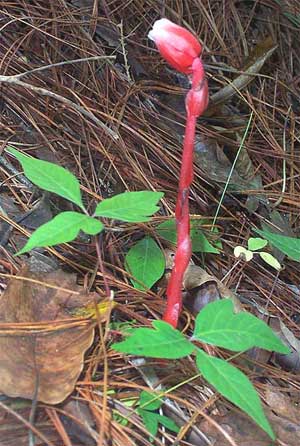Excerpts from Jim Conrad's
Naturalist Newsletter
from the October 29, 2007 Newsletter issued from Yerba Buena Clinic just outside Pueblo Nuevo Solistahuacan, Chiapas, MÉXICO
about 1740 meters in elevation, ± LAT. 17° 11' 27"N, LONG. -92° 53' 35"W
INDIAN PIPE

Many of you will recognize the plant shown above. It's Indian Pipe. The last I heard, people here were calling it MONOTROPA UNIFLORA*, which is the very same name used for the plant traditionally considered to be distributed in much of North and South America, and eastern Asia. However, studies in genetic sequencing indicate that several species may be involved, so who knows what name our plants may end up with?
Though anatomically I can't see any difference between Chiapas's and North America's Indian Pipes, the one's I've seen up there have been white, or maybe with just a tinge of pink in them. Up there I've never seen a bright red one like those here.
In Mexico Indian Pipes live in the humid mountains, typically occurring below pines and oaks. You can see that the plant entirely lacks chlorophyll. There's been a debate about how the species gets its food, since it can't photosynthesize what it needs. A closely related species, Monotropsis odorata, obtains its nutrients through an association with a mycorrhizal fungus, so maybe that's the case here.
In the picture, below the Indian Pipe you'll see yet another of our Ice Age relicts, and something all too familiar to eastern North Americans -- Poison Ivy, Toxicodendron radicans.